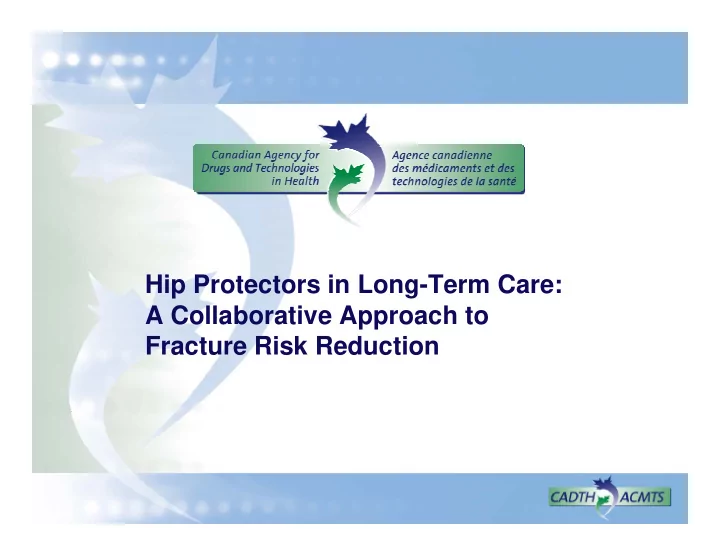

Hip Protectors in Long-Term Care: A Collaborative Approach to Fracture Risk Reduction
Overview Presentation Objectives: • Background: Hip Protector issues • Hip Protectors Project Project Importance & Collaborative process Guidance Summary Implementation Tools • Key Messages
The Issues Hip fractures are a significant health risk for seniors. Hip fractures may be reduced through: • prevention and treatment of osteoporosis • prevention of falling • use of hip protectors. …..recognizing that: • Hip protectors can be effective in preventing hip fractures when worn at the time of a fall. • Not all hip protectors are equally effective and may be more beneficial for some • Effectiveness of hip protectors is influenced by the consistency with which they are worn.
Background: Hip Protectors What Are Hip Protectors? • Garments or undergarments with pockets on each side, into which protective pads are inserted or permanently embedded. • Protective pads may be hard or soft-shelled. • In the event of a fall, the pad absorbs or disperses the force away from the hip.
Hip Protectors Project At the request of 3 provinces, CADTH recently provided policy guidance and implementation tools related to hip protector use in long-term care facilities. This work addressed issues of how to: • consider available hip fracture prevention DEVICE strategies in elderly residents of Long-Term Care (LTC) care facilities • promote health and well-being of the residents • reduce the burden on the health care system resulting from hip injuries.
Process Used occupational therapy geriatrics physiotherapy long-term care administration nursing program management
Evidence-Informed Findings • Hip protectors had a protective effect on hip fractures for elderly in residential care (5 systematic reviews). • Four of six clinical practice guidelines recommended the use of hip protectors (varying grades of evidence). • Evaluations done in Canadian settings found hip protectors likely to be cost-saving (3 economic evaluations) but did not compare hard versus shoft-shell. • Compliance and impact on ADLs were important issues in hip protector research and implementation. • Hip protectors (if used consistently) may reduce the risk of hip fractures by 23% (for women over 70 years of age in long- term care facilities, assuming typical rates of compliance).
Baseline Primary Economic Model results for an 80- to 84-year-old osteoporotic woman living in LTC with a previous osteoporotic fracture
Guidance Summary Consider the inclusion of hip protectors as an element of seniors’ injury prevention strategies, allowing provision of hip protectors to long-term care residents assessed as being at increased risk of falling. Clinicians should employ a specific set of criteria for determining which residents of long-term care are at the greatest risk of falling, and for which of those residents hip protectors would not interfere with ADLs.
Decision makers may consider targeting… LTC facility residents with these risk factors (most likely to benefit from hip protectors): • Hypertension • Incontinence • Previous history of falls and fractures • Cognitive impairment • Stroke (especially hemiplegia) • Dementia, disorders of gait and balance • Parkinson’s disease • Peripheral neuropathy • Lower extremity weakness or sensory loss • Lower body mass indexes • Substantial vision loss.
Implementation Tools (Guidance Cards) Visit the CADTH exhibit for guidance on hip protectors: http://www.cadth.ca/index.php/en/hta/ reports-publications/recommendations/policy-guid-hip-protect
Collaboration for Fracture Prevention • Hip Protectors may be an excellent evidence- informed intervention to add into existing falls prevention program planning or strategies in facilities or regions • Awareness building and education opportunities for both residents and families about potential value may support uptake and consistent usage • When combined with other interventions (bisphosphonates; and comprehensive falls preventions strategies), definitive enhanced benefits in fracture prevention may be realized • Practical implementation factors need to be further considered on a patient-by-patient basis
Recommend
More recommend